8 places in North Rhine-Westphalia to escape the heat this summer

From castles to natural pools, these are the best places to escape the sizzling German summer in North Rhine-Westphalia.
Teutoburg Forest
The ancient forest of Teutoburg is the perfect place for outdoors lovers to take a cool, leisurely, hike on warm days.
Filled with dense woodlands, rolling hills and valleys, the forest is a real escape into nature. It's home to one of Germany's most famous hiking trails - Hermannsweg - which winds its way through the forest and onto the Egge Mountains, extending for approximately 156 kilometres (though we don’t recommend you try to walk the whole trail in one day).
But there are also shorter routes through the forest, such as the Dörenther Klippen hiking route which passes plenty of landmarks, such as the 40-metre-high Externsteine near Horn-Bad Meinberg and the Hermann Monument near Detmold.
The Atta Cave
What better place to escape the heat than underground?
The Atta Cave, also known as the Attendorn Dripstone Cave (or the Attendorn Tropfsteinhöhle), is considered one of the most impressive dripstone caves in Europe and is very popular with tourists.

The Atta Cave or Attendorn Dripstone Cave in Attendorn is considered one of the largest and most beautiful dripstone caves in Germany. Photo: picture alliance/dpa/Atendorner Tropfsteinhöhle
Around 1.5 kilometres of the 6-kilometres-wide cave system is open to the public and visitors can explore dripstone formations, stalactites, stalagmites, and other unique geological features.
Visitors can also take guided tours through the caves to learn about the geological processes, as well as the cave's history and ecosystems.
READ ALSO: 8 of the coolest places in Germany to visit on hot summer days
The best thing about the cave for those wanting to shelter from the heat is the permanently cool temperature inside, which stays at around 9C throughout the year.
Otto Maigler See
Lake Otto Maigler is one of the most well-known bathing lakes near Cologne and one of the most popular lakes in North Rhine-Westphalia.
Nestled amidst green surroundings, nature lovers will find plenty to enjoy here as the lake is known for its natural beauty and serves as a habitat for various bird species.
READ ALSO: 'Go early and stay late': Your tips for making the most of Germany's lakes
For those wanting to swim or try their hand at water-sports, the lake also has a lido with a 500-metre-long beach and rowing and sailing clubs nearby.
Otto Maigler See hosts various events and festivals during the summer season, including open-air concerts and water sports competitions, so check beforehand to see if there's anything exciting going on.
Burg Satzvey
Satzvey Castle is one of the most beautiful and well-preserved so-called Wasserschlösser (water castles) in the Rhineland.

Burg Satzvey in Euskirchen. Photo: DiAuras / Wikimedia Commons
Located around 50 kilometres southwest of Bonn, the medieval castle offers a great retreat from the sun within its stone walls. The castle traces its origins back to at least the 14th century, and its medieval structures are well worth exploring.
Also, being a Wasserschloss, it's surrounded by water, which also helps keep the temperature down on those warmer days.
Möhnesee
Due to its size, the Möhne Lake is also also known as "the Westphalian Sea". Located around 60 kilometres east of Dortmund, the body of water has won the coveted title of "North Rhine-Westphalia's Favourite Lake" several times.
There are two free bathing spots on the Lake, in Delecke and in the Seepark Körbecke, while paying visitors can enjoy some Caribbean bathing flair on the Uferlos lido with white sand, beach chairs and a cocktail bar.
The area around the lake, in the Arnsberg Forest Nature Park, offers a wide range of activities for visitors to enjoy too: from boating and hiking to traversing the Liethsteilhang walkway, suspended 30 meters above the ground.

Spotlights illuminate the Möhne dam. Photo: picture alliance / Julian Stratenschulte/dpa | Julian Stratenschulte
For history enthusiasts, the imposing Möhnedamm - the scene of the Dambuster's Operation during WWII - is also worth a visit.
Naturfreibad Heil
For an outdoor dip with a difference, why not try heading to the Heil Natural Outdoor Pool in Bergkamen, around 20 kilometres northeast of Dortmund?
READ ALSO: How to stay safe while swimming outdoors in Germany this summer
In the middle of a forest, Naturfreibad Heil is a natural swimming pool sourced from purified water from a natural spring, offering a very eco-friendly swimming experience.
Reichswald Kleve
For those willing to venture a bit further out of the major North Rhine-Westphalian cities for some shade, Reichswald Kleve is another stunning forest on the German-Dutch border. It's the largest uninterrupted public state forest in North Rhine-Westphalia and crosses the municipal areas of Goch, Kleve, Kranenburg and Bedburg-Hau in the district of Kleve.
Located on the Lower Rhine ridge, part of the forest was once pushed up by ice-age glaciers, which left behind rock elevations which jut out of the greenery and reach heights of over 50 metres. The forest is mainly dominated by oak and beech trees and wild plants and animals can develop here undisturbed.
The forest has a rich history, too. Reichswald was first mentioned in the middle of the 14th century when the area belonged to the imperial palace in the Netherlands. Holy Roman Emperor Otto III was born here in 980, near the village of Kessel, while his mother was on the way to the imperial palace.
READ ALSO: 10 odd tourist attractions in Germany you shouldn't miss
Sechs-Seen-Platte
As the name suggests, the Sechs-Seen-Platte is a wide-reaching recreational area in the Ruhr region North Rhine-Westphalia, known for its six interconnected, man-made lakes. The area spans Duisburg, Oberhausen, and Bottrop and covers around 20 square kilometres.

A couple watches the bathers in the lake from their deck chairs at the Sechs-Seen-Platte in Duisburg. Photo: picture alliance / dpa | Roland Weihrauch
While all of the lakes offer water activities such as swimming, boating, and fishing, each lake has its own individual attraction: Baldeneysee is particularly good for sailing, Hengsteysee for natural beauty, Kemnader See for beaches and water sports, Phoenixsee is a vibrant urban redevelopment, Harkortsee is best for tranquillity, and Wittringen is adored for its castle and park.
The area also features numerous scenic walking and cycling paths, as well as plenty of restaurants and picnic areas.
Comments
See Also
Teutoburg Forest
The ancient forest of Teutoburg is the perfect place for outdoors lovers to take a cool, leisurely, hike on warm days.
Filled with dense woodlands, rolling hills and valleys, the forest is a real escape into nature. It's home to one of Germany's most famous hiking trails - Hermannsweg - which winds its way through the forest and onto the Egge Mountains, extending for approximately 156 kilometres (though we don’t recommend you try to walk the whole trail in one day).
But there are also shorter routes through the forest, such as the Dörenther Klippen hiking route which passes plenty of landmarks, such as the 40-metre-high Externsteine near Horn-Bad Meinberg and the Hermann Monument near Detmold.
The Atta Cave
What better place to escape the heat than underground?
The Atta Cave, also known as the Attendorn Dripstone Cave (or the Attendorn Tropfsteinhöhle), is considered one of the most impressive dripstone caves in Europe and is very popular with tourists.

Around 1.5 kilometres of the 6-kilometres-wide cave system is open to the public and visitors can explore dripstone formations, stalactites, stalagmites, and other unique geological features.
Visitors can also take guided tours through the caves to learn about the geological processes, as well as the cave's history and ecosystems.
READ ALSO: 8 of the coolest places in Germany to visit on hot summer days
The best thing about the cave for those wanting to shelter from the heat is the permanently cool temperature inside, which stays at around 9C throughout the year.
Otto Maigler See
Lake Otto Maigler is one of the most well-known bathing lakes near Cologne and one of the most popular lakes in North Rhine-Westphalia.
Nestled amidst green surroundings, nature lovers will find plenty to enjoy here as the lake is known for its natural beauty and serves as a habitat for various bird species.
READ ALSO: 'Go early and stay late': Your tips for making the most of Germany's lakes
For those wanting to swim or try their hand at water-sports, the lake also has a lido with a 500-metre-long beach and rowing and sailing clubs nearby.
Otto Maigler See hosts various events and festivals during the summer season, including open-air concerts and water sports competitions, so check beforehand to see if there's anything exciting going on.
Burg Satzvey
Satzvey Castle is one of the most beautiful and well-preserved so-called Wasserschlösser (water castles) in the Rhineland.

Located around 50 kilometres southwest of Bonn, the medieval castle offers a great retreat from the sun within its stone walls. The castle traces its origins back to at least the 14th century, and its medieval structures are well worth exploring.
Also, being a Wasserschloss, it's surrounded by water, which also helps keep the temperature down on those warmer days.
Möhnesee
Due to its size, the Möhne Lake is also also known as "the Westphalian Sea". Located around 60 kilometres east of Dortmund, the body of water has won the coveted title of "North Rhine-Westphalia's Favourite Lake" several times.
There are two free bathing spots on the Lake, in Delecke and in the Seepark Körbecke, while paying visitors can enjoy some Caribbean bathing flair on the Uferlos lido with white sand, beach chairs and a cocktail bar.
The area around the lake, in the Arnsberg Forest Nature Park, offers a wide range of activities for visitors to enjoy too: from boating and hiking to traversing the Liethsteilhang walkway, suspended 30 meters above the ground.

For history enthusiasts, the imposing Möhnedamm - the scene of the Dambuster's Operation during WWII - is also worth a visit.
Naturfreibad Heil
For an outdoor dip with a difference, why not try heading to the Heil Natural Outdoor Pool in Bergkamen, around 20 kilometres northeast of Dortmund?
READ ALSO: How to stay safe while swimming outdoors in Germany this summer
In the middle of a forest, Naturfreibad Heil is a natural swimming pool sourced from purified water from a natural spring, offering a very eco-friendly swimming experience.
Reichswald Kleve
For those willing to venture a bit further out of the major North Rhine-Westphalian cities for some shade, Reichswald Kleve is another stunning forest on the German-Dutch border. It's the largest uninterrupted public state forest in North Rhine-Westphalia and crosses the municipal areas of Goch, Kleve, Kranenburg and Bedburg-Hau in the district of Kleve.
Located on the Lower Rhine ridge, part of the forest was once pushed up by ice-age glaciers, which left behind rock elevations which jut out of the greenery and reach heights of over 50 metres. The forest is mainly dominated by oak and beech trees and wild plants and animals can develop here undisturbed.
The forest has a rich history, too. Reichswald was first mentioned in the middle of the 14th century when the area belonged to the imperial palace in the Netherlands. Holy Roman Emperor Otto III was born here in 980, near the village of Kessel, while his mother was on the way to the imperial palace.
READ ALSO: 10 odd tourist attractions in Germany you shouldn't miss
Sechs-Seen-Platte
As the name suggests, the Sechs-Seen-Platte is a wide-reaching recreational area in the Ruhr region North Rhine-Westphalia, known for its six interconnected, man-made lakes. The area spans Duisburg, Oberhausen, and Bottrop and covers around 20 square kilometres.

While all of the lakes offer water activities such as swimming, boating, and fishing, each lake has its own individual attraction: Baldeneysee is particularly good for sailing, Hengsteysee for natural beauty, Kemnader See for beaches and water sports, Phoenixsee is a vibrant urban redevelopment, Harkortsee is best for tranquillity, and Wittringen is adored for its castle and park.
The area also features numerous scenic walking and cycling paths, as well as plenty of restaurants and picnic areas.
Join the conversation in our comments section below. Share your own views and experience and if you have a question or suggestion for our journalists then email us at [email protected].
Please keep comments civil, constructive and on topic – and make sure to read our terms of use before getting involved.
Please log in here to leave a comment.